Applying Consumer Behaviour Theories: Strategic Recommendations
VerifiedAdded on 2023/06/11
|10
|3311
|104
Essay
AI Summary
This essay provides a comprehensive analysis of consumer behaviour, exploring various theories such as the Theory of Planned Behaviour, Diffusion of Innovation Theory, and Maslow's Hierarchy of Needs. It discusses how these theories can be applied to understand consumer decision-making processes and develop effective marketing strategies. The essay also includes a case study of McDonald's new line of organic food, using the theories to develop strategic recommendations for the organization, such as opening a new McOrganic restaurant franchise. The analysis highlights the importance of considering consumer attitudes, perceived behavioral control, subjective norms, and the perceived characteristics of innovation when making strategic marketing decisions.
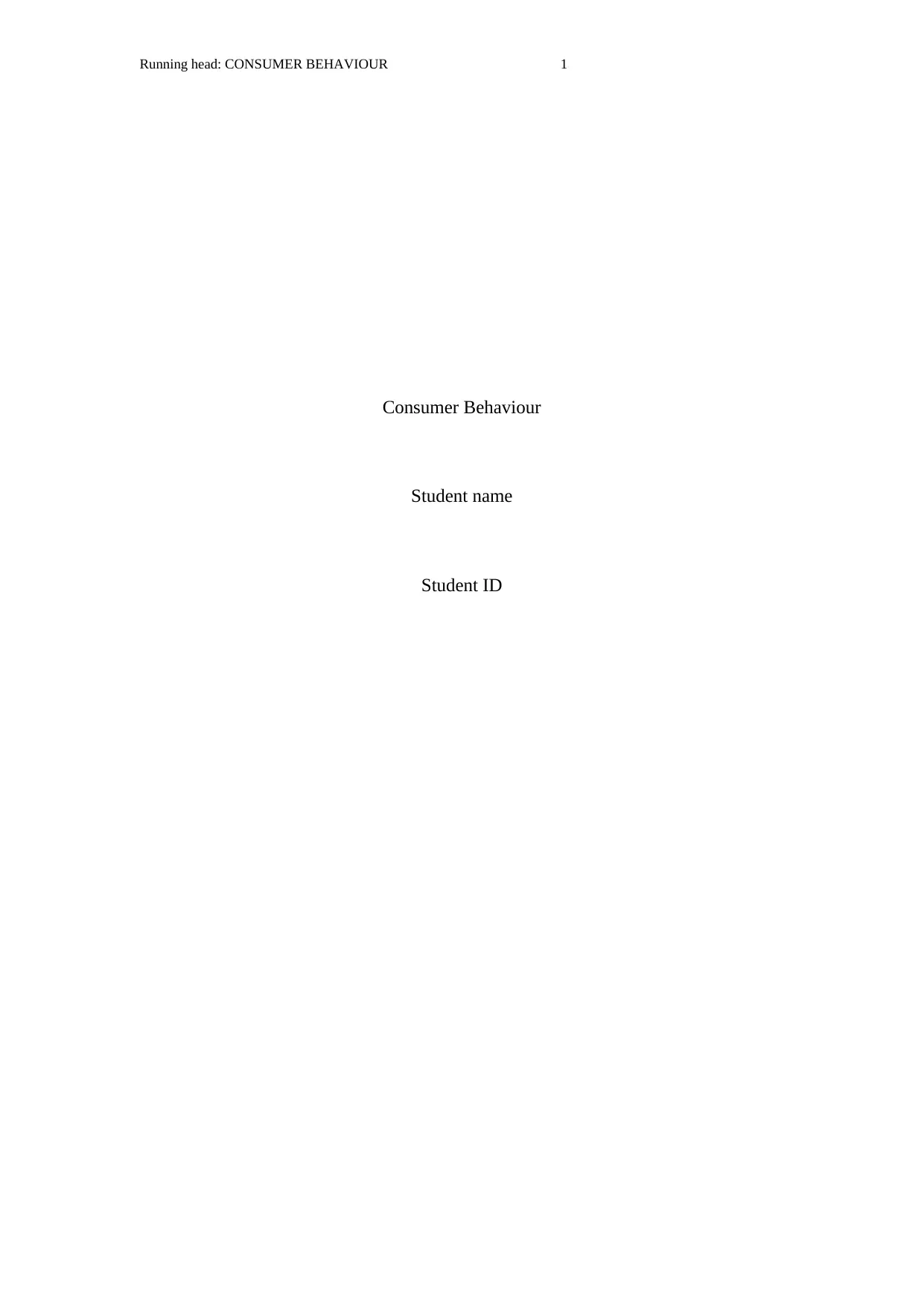
1Running head: CONSUMER BEHAVIOUR
Consumer Behaviour
Student name
Student ID
Consumer Behaviour
Student name
Student ID
Paraphrase This Document
Need a fresh take? Get an instant paraphrase of this document with our AI Paraphraser
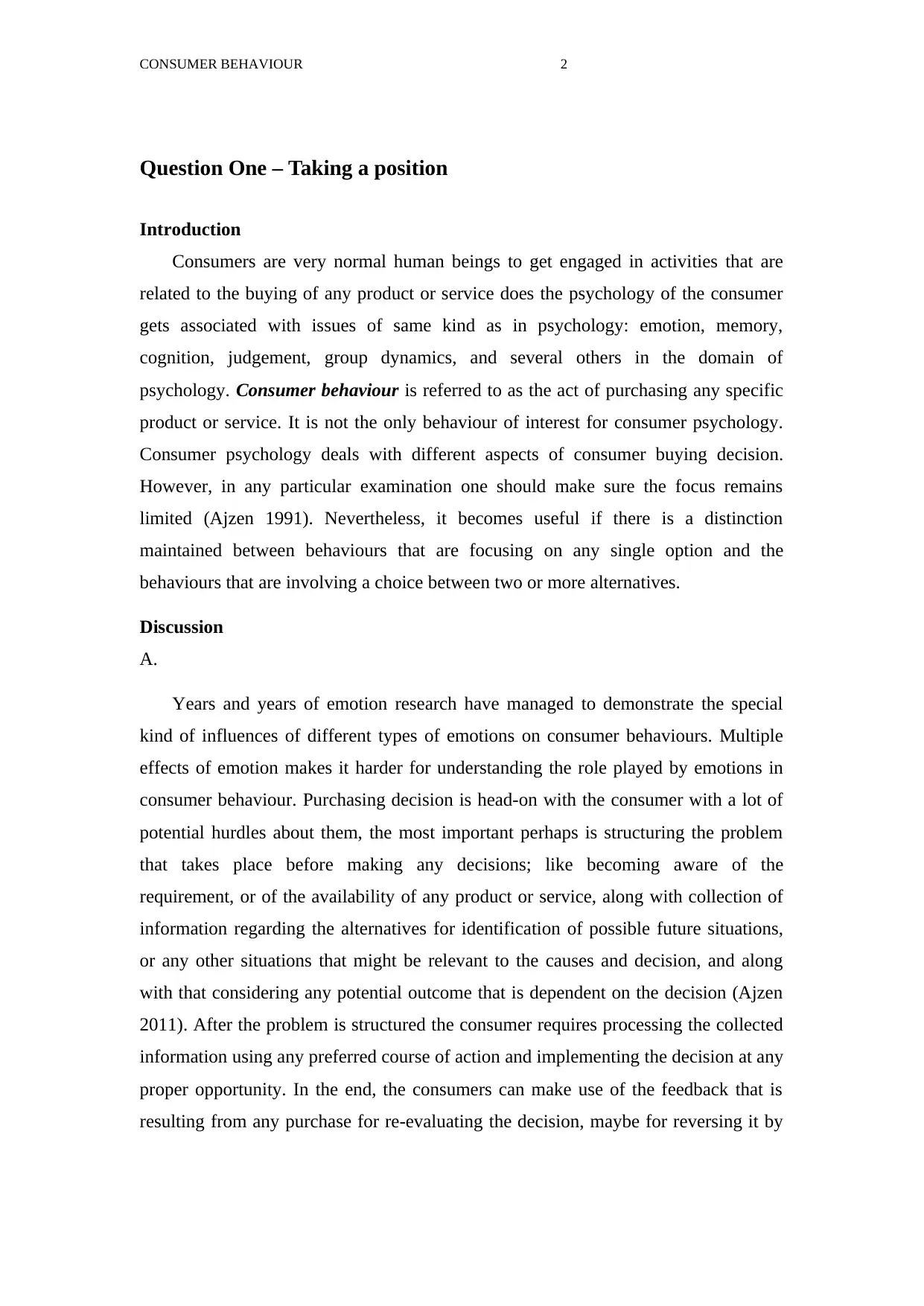
2CONSUMER BEHAVIOUR
Question One – Taking a position
Introduction
Consumers are very normal human beings to get engaged in activities that are
related to the buying of any product or service does the psychology of the consumer
gets associated with issues of same kind as in psychology: emotion, memory,
cognition, judgement, group dynamics, and several others in the domain of
psychology. Consumer behaviour is referred to as the act of purchasing any specific
product or service. It is not the only behaviour of interest for consumer psychology.
Consumer psychology deals with different aspects of consumer buying decision.
However, in any particular examination one should make sure the focus remains
limited (Ajzen 1991). Nevertheless, it becomes useful if there is a distinction
maintained between behaviours that are focusing on any single option and the
behaviours that are involving a choice between two or more alternatives.
Discussion
A.
Years and years of emotion research have managed to demonstrate the special
kind of influences of different types of emotions on consumer behaviours. Multiple
effects of emotion makes it harder for understanding the role played by emotions in
consumer behaviour. Purchasing decision is head-on with the consumer with a lot of
potential hurdles about them, the most important perhaps is structuring the problem
that takes place before making any decisions; like becoming aware of the
requirement, or of the availability of any product or service, along with collection of
information regarding the alternatives for identification of possible future situations,
or any other situations that might be relevant to the causes and decision, and along
with that considering any potential outcome that is dependent on the decision (Ajzen
2011). After the problem is structured the consumer requires processing the collected
information using any preferred course of action and implementing the decision at any
proper opportunity. In the end, the consumers can make use of the feedback that is
resulting from any purchase for re-evaluating the decision, maybe for reversing it by
Question One – Taking a position
Introduction
Consumers are very normal human beings to get engaged in activities that are
related to the buying of any product or service does the psychology of the consumer
gets associated with issues of same kind as in psychology: emotion, memory,
cognition, judgement, group dynamics, and several others in the domain of
psychology. Consumer behaviour is referred to as the act of purchasing any specific
product or service. It is not the only behaviour of interest for consumer psychology.
Consumer psychology deals with different aspects of consumer buying decision.
However, in any particular examination one should make sure the focus remains
limited (Ajzen 1991). Nevertheless, it becomes useful if there is a distinction
maintained between behaviours that are focusing on any single option and the
behaviours that are involving a choice between two or more alternatives.
Discussion
A.
Years and years of emotion research have managed to demonstrate the special
kind of influences of different types of emotions on consumer behaviours. Multiple
effects of emotion makes it harder for understanding the role played by emotions in
consumer behaviour. Purchasing decision is head-on with the consumer with a lot of
potential hurdles about them, the most important perhaps is structuring the problem
that takes place before making any decisions; like becoming aware of the
requirement, or of the availability of any product or service, along with collection of
information regarding the alternatives for identification of possible future situations,
or any other situations that might be relevant to the causes and decision, and along
with that considering any potential outcome that is dependent on the decision (Ajzen
2011). After the problem is structured the consumer requires processing the collected
information using any preferred course of action and implementing the decision at any
proper opportunity. In the end, the consumers can make use of the feedback that is
resulting from any purchase for re-evaluating the decision, maybe for reversing it by
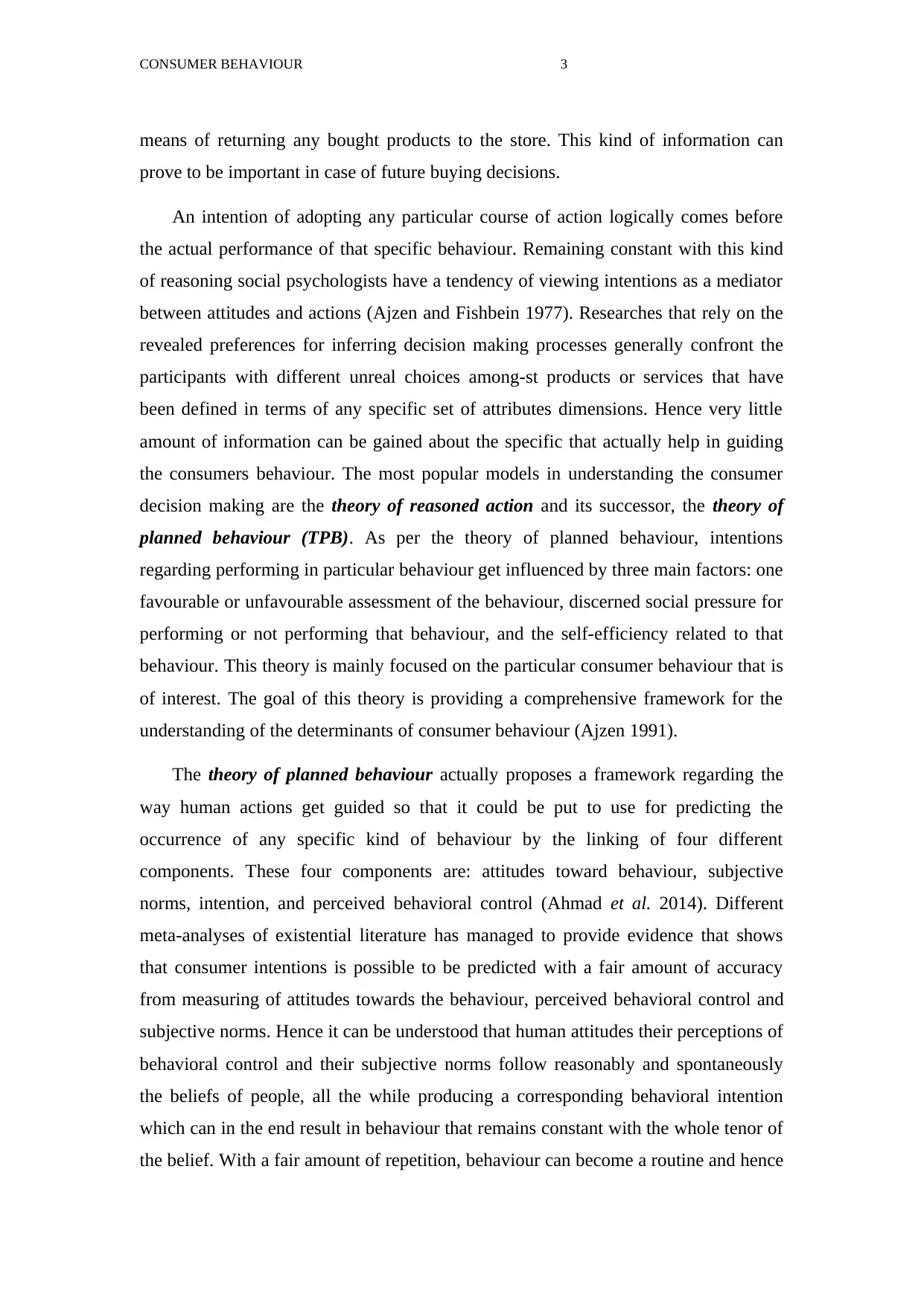
3CONSUMER BEHAVIOUR
means of returning any bought products to the store. This kind of information can
prove to be important in case of future buying decisions.
An intention of adopting any particular course of action logically comes before
the actual performance of that specific behaviour. Remaining constant with this kind
of reasoning social psychologists have a tendency of viewing intentions as a mediator
between attitudes and actions (Ajzen and Fishbein 1977). Researches that rely on the
revealed preferences for inferring decision making processes generally confront the
participants with different unreal choices among-st products or services that have
been defined in terms of any specific set of attributes dimensions. Hence very little
amount of information can be gained about the specific that actually help in guiding
the consumers behaviour. The most popular models in understanding the consumer
decision making are the theory of reasoned action and its successor, the theory of
planned behaviour (TPB). As per the theory of planned behaviour, intentions
regarding performing in particular behaviour get influenced by three main factors: one
favourable or unfavourable assessment of the behaviour, discerned social pressure for
performing or not performing that behaviour, and the self-efficiency related to that
behaviour. This theory is mainly focused on the particular consumer behaviour that is
of interest. The goal of this theory is providing a comprehensive framework for the
understanding of the determinants of consumer behaviour (Ajzen 1991).
The theory of planned behaviour actually proposes a framework regarding the
way human actions get guided so that it could be put to use for predicting the
occurrence of any specific kind of behaviour by the linking of four different
components. These four components are: attitudes toward behaviour, subjective
norms, intention, and perceived behavioral control (Ahmad et al. 2014). Different
meta-analyses of existential literature has managed to provide evidence that shows
that consumer intentions is possible to be predicted with a fair amount of accuracy
from measuring of attitudes towards the behaviour, perceived behavioral control and
subjective norms. Hence it can be understood that human attitudes their perceptions of
behavioral control and their subjective norms follow reasonably and spontaneously
the beliefs of people, all the while producing a corresponding behavioral intention
which can in the end result in behaviour that remains constant with the whole tenor of
the belief. With a fair amount of repetition, behaviour can become a routine and hence
means of returning any bought products to the store. This kind of information can
prove to be important in case of future buying decisions.
An intention of adopting any particular course of action logically comes before
the actual performance of that specific behaviour. Remaining constant with this kind
of reasoning social psychologists have a tendency of viewing intentions as a mediator
between attitudes and actions (Ajzen and Fishbein 1977). Researches that rely on the
revealed preferences for inferring decision making processes generally confront the
participants with different unreal choices among-st products or services that have
been defined in terms of any specific set of attributes dimensions. Hence very little
amount of information can be gained about the specific that actually help in guiding
the consumers behaviour. The most popular models in understanding the consumer
decision making are the theory of reasoned action and its successor, the theory of
planned behaviour (TPB). As per the theory of planned behaviour, intentions
regarding performing in particular behaviour get influenced by three main factors: one
favourable or unfavourable assessment of the behaviour, discerned social pressure for
performing or not performing that behaviour, and the self-efficiency related to that
behaviour. This theory is mainly focused on the particular consumer behaviour that is
of interest. The goal of this theory is providing a comprehensive framework for the
understanding of the determinants of consumer behaviour (Ajzen 1991).
The theory of planned behaviour actually proposes a framework regarding the
way human actions get guided so that it could be put to use for predicting the
occurrence of any specific kind of behaviour by the linking of four different
components. These four components are: attitudes toward behaviour, subjective
norms, intention, and perceived behavioral control (Ahmad et al. 2014). Different
meta-analyses of existential literature has managed to provide evidence that shows
that consumer intentions is possible to be predicted with a fair amount of accuracy
from measuring of attitudes towards the behaviour, perceived behavioral control and
subjective norms. Hence it can be understood that human attitudes their perceptions of
behavioral control and their subjective norms follow reasonably and spontaneously
the beliefs of people, all the while producing a corresponding behavioral intention
which can in the end result in behaviour that remains constant with the whole tenor of
the belief. With a fair amount of repetition, behaviour can become a routine and hence
⊘ This is a preview!⊘
Do you want full access?
Subscribe today to unlock all pages.

Trusted by 1+ million students worldwide
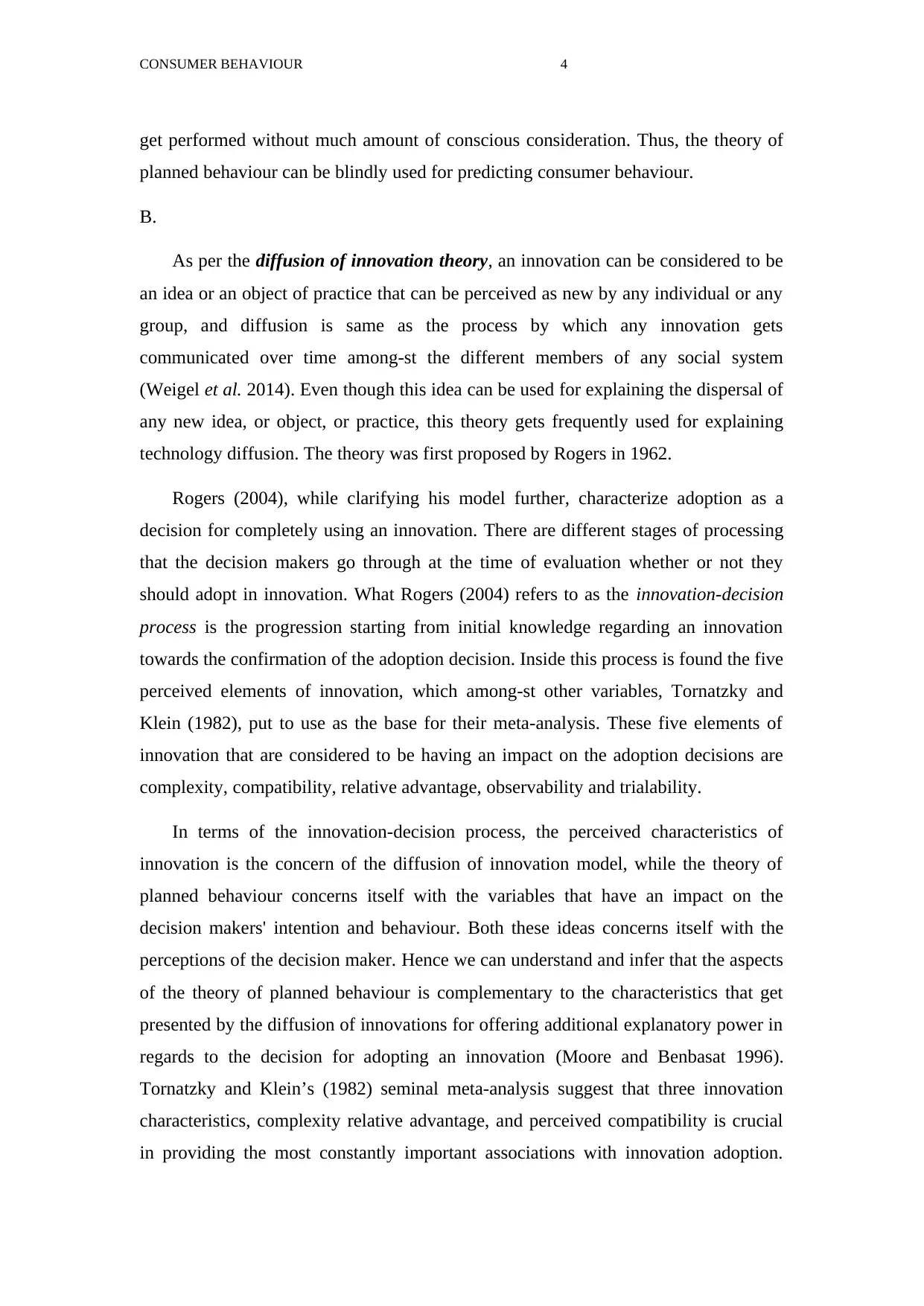
4CONSUMER BEHAVIOUR
get performed without much amount of conscious consideration. Thus, the theory of
planned behaviour can be blindly used for predicting consumer behaviour.
B.
As per the diffusion of innovation theory, an innovation can be considered to be
an idea or an object of practice that can be perceived as new by any individual or any
group, and diffusion is same as the process by which any innovation gets
communicated over time among-st the different members of any social system
(Weigel et al. 2014). Even though this idea can be used for explaining the dispersal of
any new idea, or object, or practice, this theory gets frequently used for explaining
technology diffusion. The theory was first proposed by Rogers in 1962.
Rogers (2004), while clarifying his model further, characterize adoption as a
decision for completely using an innovation. There are different stages of processing
that the decision makers go through at the time of evaluation whether or not they
should adopt in innovation. What Rogers (2004) refers to as the innovation-decision
process is the progression starting from initial knowledge regarding an innovation
towards the confirmation of the adoption decision. Inside this process is found the five
perceived elements of innovation, which among-st other variables, Tornatzky and
Klein (1982), put to use as the base for their meta-analysis. These five elements of
innovation that are considered to be having an impact on the adoption decisions are
complexity, compatibility, relative advantage, observability and trialability.
In terms of the innovation-decision process, the perceived characteristics of
innovation is the concern of the diffusion of innovation model, while the theory of
planned behaviour concerns itself with the variables that have an impact on the
decision makers' intention and behaviour. Both these ideas concerns itself with the
perceptions of the decision maker. Hence we can understand and infer that the aspects
of the theory of planned behaviour is complementary to the characteristics that get
presented by the diffusion of innovations for offering additional explanatory power in
regards to the decision for adopting an innovation (Moore and Benbasat 1996).
Tornatzky and Klein’s (1982) seminal meta-analysis suggest that three innovation
characteristics, complexity relative advantage, and perceived compatibility is crucial
in providing the most constantly important associations with innovation adoption.
get performed without much amount of conscious consideration. Thus, the theory of
planned behaviour can be blindly used for predicting consumer behaviour.
B.
As per the diffusion of innovation theory, an innovation can be considered to be
an idea or an object of practice that can be perceived as new by any individual or any
group, and diffusion is same as the process by which any innovation gets
communicated over time among-st the different members of any social system
(Weigel et al. 2014). Even though this idea can be used for explaining the dispersal of
any new idea, or object, or practice, this theory gets frequently used for explaining
technology diffusion. The theory was first proposed by Rogers in 1962.
Rogers (2004), while clarifying his model further, characterize adoption as a
decision for completely using an innovation. There are different stages of processing
that the decision makers go through at the time of evaluation whether or not they
should adopt in innovation. What Rogers (2004) refers to as the innovation-decision
process is the progression starting from initial knowledge regarding an innovation
towards the confirmation of the adoption decision. Inside this process is found the five
perceived elements of innovation, which among-st other variables, Tornatzky and
Klein (1982), put to use as the base for their meta-analysis. These five elements of
innovation that are considered to be having an impact on the adoption decisions are
complexity, compatibility, relative advantage, observability and trialability.
In terms of the innovation-decision process, the perceived characteristics of
innovation is the concern of the diffusion of innovation model, while the theory of
planned behaviour concerns itself with the variables that have an impact on the
decision makers' intention and behaviour. Both these ideas concerns itself with the
perceptions of the decision maker. Hence we can understand and infer that the aspects
of the theory of planned behaviour is complementary to the characteristics that get
presented by the diffusion of innovations for offering additional explanatory power in
regards to the decision for adopting an innovation (Moore and Benbasat 1996).
Tornatzky and Klein’s (1982) seminal meta-analysis suggest that three innovation
characteristics, complexity relative advantage, and perceived compatibility is crucial
in providing the most constantly important associations with innovation adoption.
Paraphrase This Document
Need a fresh take? Get an instant paraphrase of this document with our AI Paraphraser
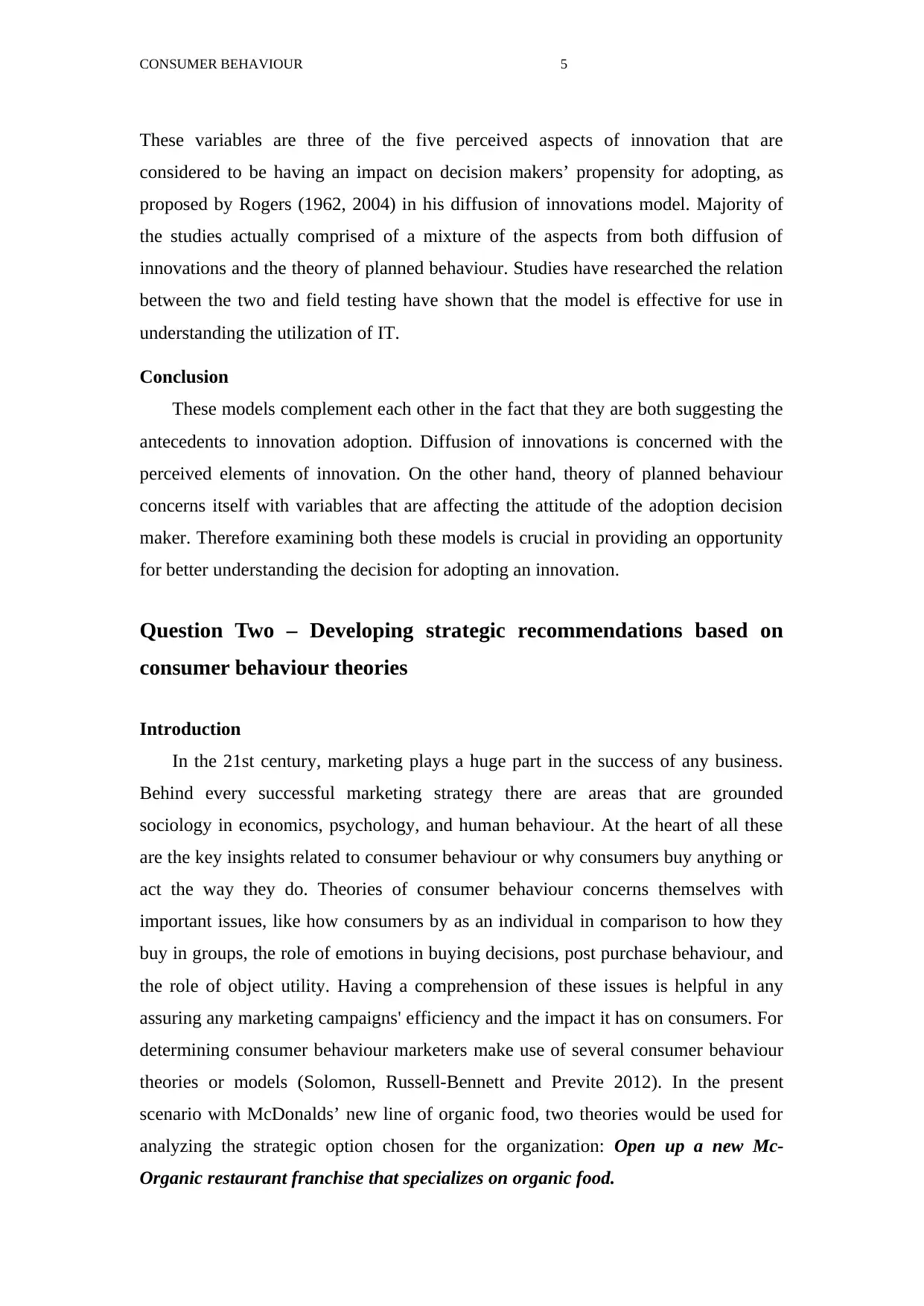
5CONSUMER BEHAVIOUR
These variables are three of the five perceived aspects of innovation that are
considered to be having an impact on decision makers’ propensity for adopting, as
proposed by Rogers (1962, 2004) in his diffusion of innovations model. Majority of
the studies actually comprised of a mixture of the aspects from both diffusion of
innovations and the theory of planned behaviour. Studies have researched the relation
between the two and field testing have shown that the model is effective for use in
understanding the utilization of IT.
Conclusion
These models complement each other in the fact that they are both suggesting the
antecedents to innovation adoption. Diffusion of innovations is concerned with the
perceived elements of innovation. On the other hand, theory of planned behaviour
concerns itself with variables that are affecting the attitude of the adoption decision
maker. Therefore examining both these models is crucial in providing an opportunity
for better understanding the decision for adopting an innovation.
Question Two – Developing strategic recommendations based on
consumer behaviour theories
Introduction
In the 21st century, marketing plays a huge part in the success of any business.
Behind every successful marketing strategy there are areas that are grounded
sociology in economics, psychology, and human behaviour. At the heart of all these
are the key insights related to consumer behaviour or why consumers buy anything or
act the way they do. Theories of consumer behaviour concerns themselves with
important issues, like how consumers by as an individual in comparison to how they
buy in groups, the role of emotions in buying decisions, post purchase behaviour, and
the role of object utility. Having a comprehension of these issues is helpful in any
assuring any marketing campaigns' efficiency and the impact it has on consumers. For
determining consumer behaviour marketers make use of several consumer behaviour
theories or models (Solomon, Russell-Bennett and Previte 2012). In the present
scenario with McDonalds’ new line of organic food, two theories would be used for
analyzing the strategic option chosen for the organization: Open up a new Mc-
Organic restaurant franchise that specializes on organic food.
These variables are three of the five perceived aspects of innovation that are
considered to be having an impact on decision makers’ propensity for adopting, as
proposed by Rogers (1962, 2004) in his diffusion of innovations model. Majority of
the studies actually comprised of a mixture of the aspects from both diffusion of
innovations and the theory of planned behaviour. Studies have researched the relation
between the two and field testing have shown that the model is effective for use in
understanding the utilization of IT.
Conclusion
These models complement each other in the fact that they are both suggesting the
antecedents to innovation adoption. Diffusion of innovations is concerned with the
perceived elements of innovation. On the other hand, theory of planned behaviour
concerns itself with variables that are affecting the attitude of the adoption decision
maker. Therefore examining both these models is crucial in providing an opportunity
for better understanding the decision for adopting an innovation.
Question Two – Developing strategic recommendations based on
consumer behaviour theories
Introduction
In the 21st century, marketing plays a huge part in the success of any business.
Behind every successful marketing strategy there are areas that are grounded
sociology in economics, psychology, and human behaviour. At the heart of all these
are the key insights related to consumer behaviour or why consumers buy anything or
act the way they do. Theories of consumer behaviour concerns themselves with
important issues, like how consumers by as an individual in comparison to how they
buy in groups, the role of emotions in buying decisions, post purchase behaviour, and
the role of object utility. Having a comprehension of these issues is helpful in any
assuring any marketing campaigns' efficiency and the impact it has on consumers. For
determining consumer behaviour marketers make use of several consumer behaviour
theories or models (Solomon, Russell-Bennett and Previte 2012). In the present
scenario with McDonalds’ new line of organic food, two theories would be used for
analyzing the strategic option chosen for the organization: Open up a new Mc-
Organic restaurant franchise that specializes on organic food.
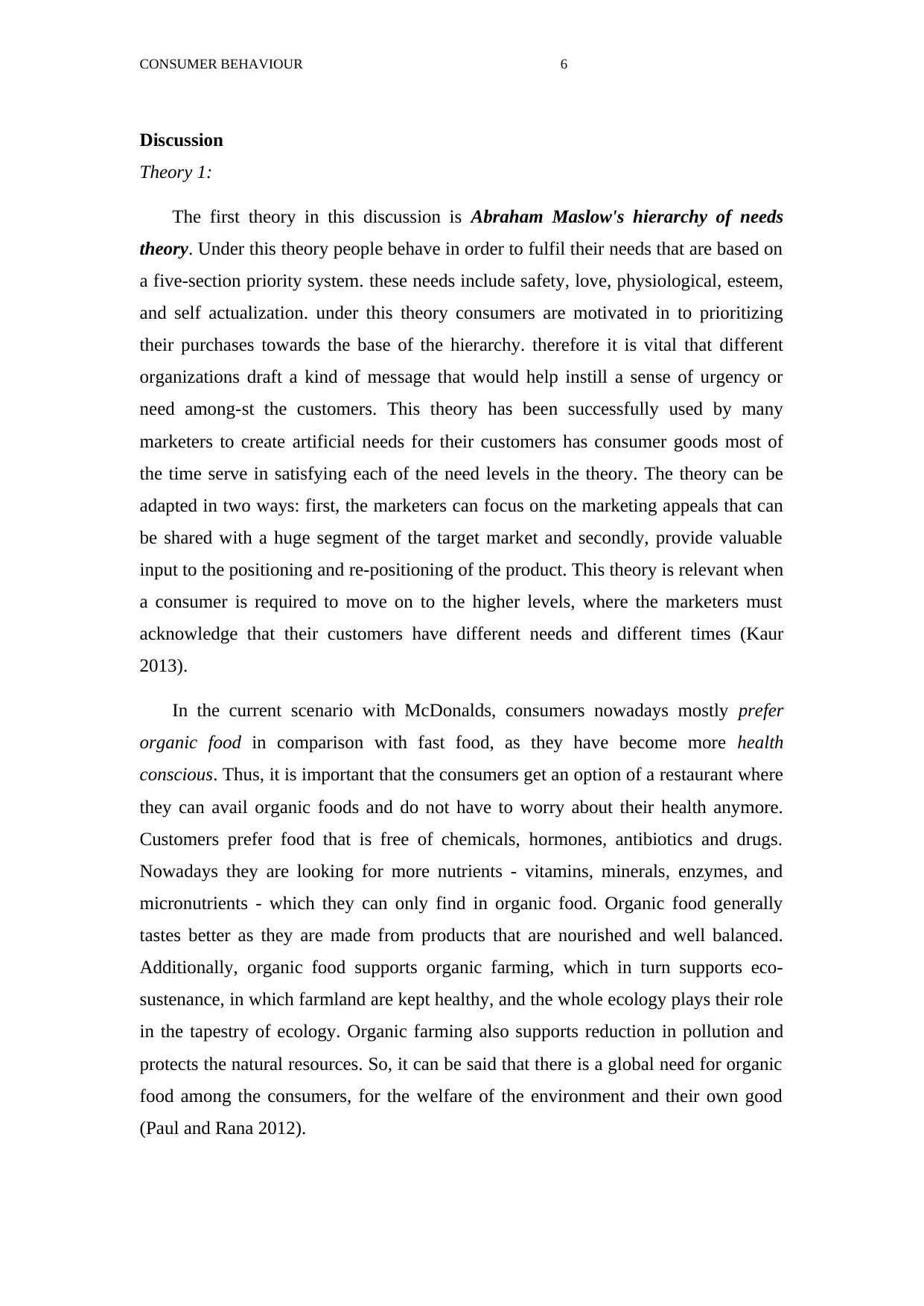
6CONSUMER BEHAVIOUR
Discussion
Theory 1:
The first theory in this discussion is Abraham Maslow's hierarchy of needs
theory. Under this theory people behave in order to fulfil their needs that are based on
a five-section priority system. these needs include safety, love, physiological, esteem,
and self actualization. under this theory consumers are motivated in to prioritizing
their purchases towards the base of the hierarchy. therefore it is vital that different
organizations draft a kind of message that would help instill a sense of urgency or
need among-st the customers. This theory has been successfully used by many
marketers to create artificial needs for their customers has consumer goods most of
the time serve in satisfying each of the need levels in the theory. The theory can be
adapted in two ways: first, the marketers can focus on the marketing appeals that can
be shared with a huge segment of the target market and secondly, provide valuable
input to the positioning and re-positioning of the product. This theory is relevant when
a consumer is required to move on to the higher levels, where the marketers must
acknowledge that their customers have different needs and different times (Kaur
2013).
In the current scenario with McDonalds, consumers nowadays mostly prefer
organic food in comparison with fast food, as they have become more health
conscious. Thus, it is important that the consumers get an option of a restaurant where
they can avail organic foods and do not have to worry about their health anymore.
Customers prefer food that is free of chemicals, hormones, antibiotics and drugs.
Nowadays they are looking for more nutrients - vitamins, minerals, enzymes, and
micronutrients - which they can only find in organic food. Organic food generally
tastes better as they are made from products that are nourished and well balanced.
Additionally, organic food supports organic farming, which in turn supports eco-
sustenance, in which farmland are kept healthy, and the whole ecology plays their role
in the tapestry of ecology. Organic farming also supports reduction in pollution and
protects the natural resources. So, it can be said that there is a global need for organic
food among the consumers, for the welfare of the environment and their own good
(Paul and Rana 2012).
Discussion
Theory 1:
The first theory in this discussion is Abraham Maslow's hierarchy of needs
theory. Under this theory people behave in order to fulfil their needs that are based on
a five-section priority system. these needs include safety, love, physiological, esteem,
and self actualization. under this theory consumers are motivated in to prioritizing
their purchases towards the base of the hierarchy. therefore it is vital that different
organizations draft a kind of message that would help instill a sense of urgency or
need among-st the customers. This theory has been successfully used by many
marketers to create artificial needs for their customers has consumer goods most of
the time serve in satisfying each of the need levels in the theory. The theory can be
adapted in two ways: first, the marketers can focus on the marketing appeals that can
be shared with a huge segment of the target market and secondly, provide valuable
input to the positioning and re-positioning of the product. This theory is relevant when
a consumer is required to move on to the higher levels, where the marketers must
acknowledge that their customers have different needs and different times (Kaur
2013).
In the current scenario with McDonalds, consumers nowadays mostly prefer
organic food in comparison with fast food, as they have become more health
conscious. Thus, it is important that the consumers get an option of a restaurant where
they can avail organic foods and do not have to worry about their health anymore.
Customers prefer food that is free of chemicals, hormones, antibiotics and drugs.
Nowadays they are looking for more nutrients - vitamins, minerals, enzymes, and
micronutrients - which they can only find in organic food. Organic food generally
tastes better as they are made from products that are nourished and well balanced.
Additionally, organic food supports organic farming, which in turn supports eco-
sustenance, in which farmland are kept healthy, and the whole ecology plays their role
in the tapestry of ecology. Organic farming also supports reduction in pollution and
protects the natural resources. So, it can be said that there is a global need for organic
food among the consumers, for the welfare of the environment and their own good
(Paul and Rana 2012).
⊘ This is a preview!⊘
Do you want full access?
Subscribe today to unlock all pages.

Trusted by 1+ million students worldwide
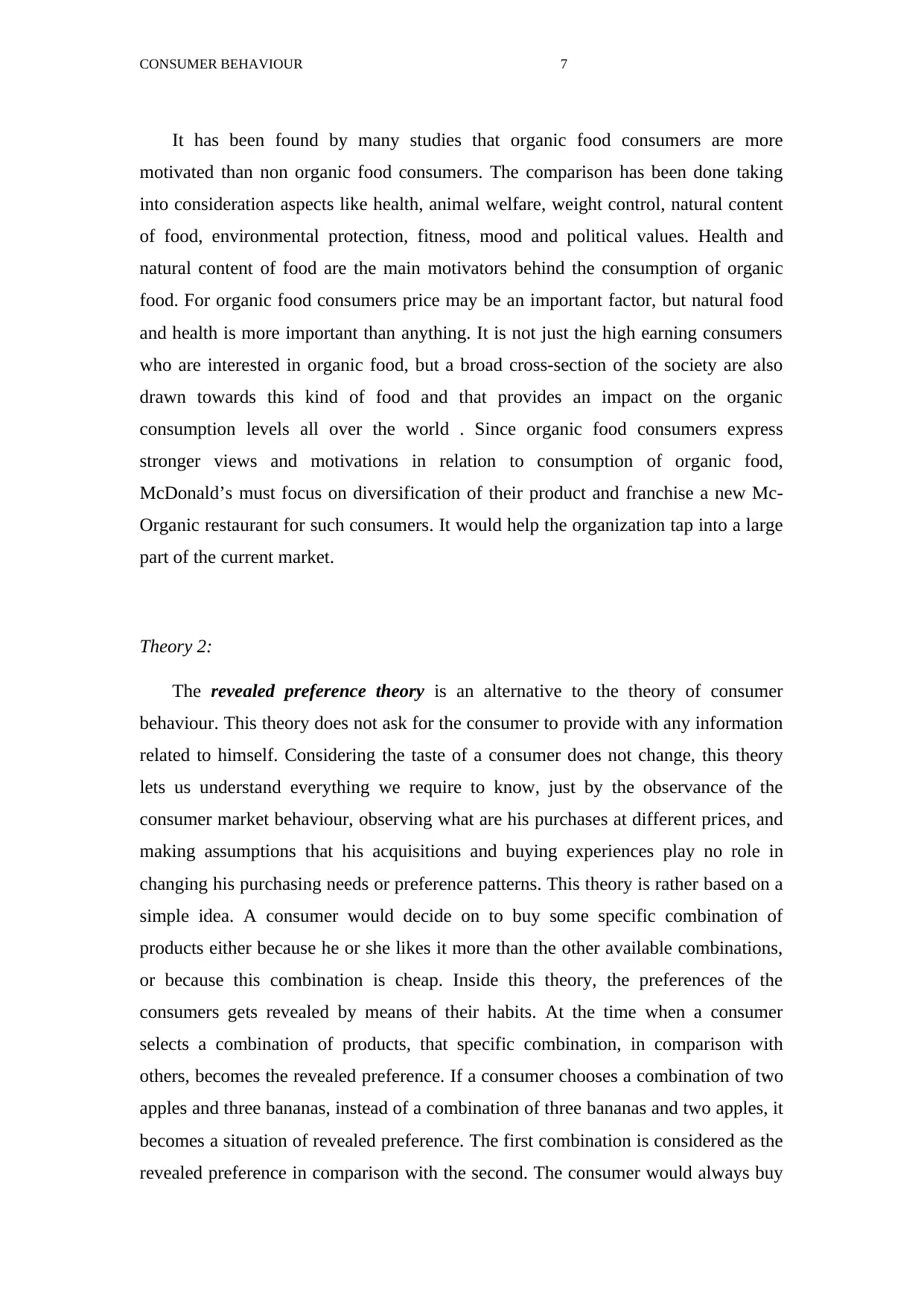
7CONSUMER BEHAVIOUR
It has been found by many studies that organic food consumers are more
motivated than non organic food consumers. The comparison has been done taking
into consideration aspects like health, animal welfare, weight control, natural content
of food, environmental protection, fitness, mood and political values. Health and
natural content of food are the main motivators behind the consumption of organic
food. For organic food consumers price may be an important factor, but natural food
and health is more important than anything. It is not just the high earning consumers
who are interested in organic food, but a broad cross-section of the society are also
drawn towards this kind of food and that provides an impact on the organic
consumption levels all over the world . Since organic food consumers express
stronger views and motivations in relation to consumption of organic food,
McDonald’s must focus on diversification of their product and franchise a new Mc-
Organic restaurant for such consumers. It would help the organization tap into a large
part of the current market.
Theory 2:
The revealed preference theory is an alternative to the theory of consumer
behaviour. This theory does not ask for the consumer to provide with any information
related to himself. Considering the taste of a consumer does not change, this theory
lets us understand everything we require to know, just by the observance of the
consumer market behaviour, observing what are his purchases at different prices, and
making assumptions that his acquisitions and buying experiences play no role in
changing his purchasing needs or preference patterns. This theory is rather based on a
simple idea. A consumer would decide on to buy some specific combination of
products either because he or she likes it more than the other available combinations,
or because this combination is cheap. Inside this theory, the preferences of the
consumers gets revealed by means of their habits. At the time when a consumer
selects a combination of products, that specific combination, in comparison with
others, becomes the revealed preference. If a consumer chooses a combination of two
apples and three bananas, instead of a combination of three bananas and two apples, it
becomes a situation of revealed preference. The first combination is considered as the
revealed preference in comparison with the second. The consumer would always buy
It has been found by many studies that organic food consumers are more
motivated than non organic food consumers. The comparison has been done taking
into consideration aspects like health, animal welfare, weight control, natural content
of food, environmental protection, fitness, mood and political values. Health and
natural content of food are the main motivators behind the consumption of organic
food. For organic food consumers price may be an important factor, but natural food
and health is more important than anything. It is not just the high earning consumers
who are interested in organic food, but a broad cross-section of the society are also
drawn towards this kind of food and that provides an impact on the organic
consumption levels all over the world . Since organic food consumers express
stronger views and motivations in relation to consumption of organic food,
McDonald’s must focus on diversification of their product and franchise a new Mc-
Organic restaurant for such consumers. It would help the organization tap into a large
part of the current market.
Theory 2:
The revealed preference theory is an alternative to the theory of consumer
behaviour. This theory does not ask for the consumer to provide with any information
related to himself. Considering the taste of a consumer does not change, this theory
lets us understand everything we require to know, just by the observance of the
consumer market behaviour, observing what are his purchases at different prices, and
making assumptions that his acquisitions and buying experiences play no role in
changing his purchasing needs or preference patterns. This theory is rather based on a
simple idea. A consumer would decide on to buy some specific combination of
products either because he or she likes it more than the other available combinations,
or because this combination is cheap. Inside this theory, the preferences of the
consumers gets revealed by means of their habits. At the time when a consumer
selects a combination of products, that specific combination, in comparison with
others, becomes the revealed preference. If a consumer chooses a combination of two
apples and three bananas, instead of a combination of three bananas and two apples, it
becomes a situation of revealed preference. The first combination is considered as the
revealed preference in comparison with the second. The consumer would always buy
Paraphrase This Document
Need a fresh take? Get an instant paraphrase of this document with our AI Paraphraser
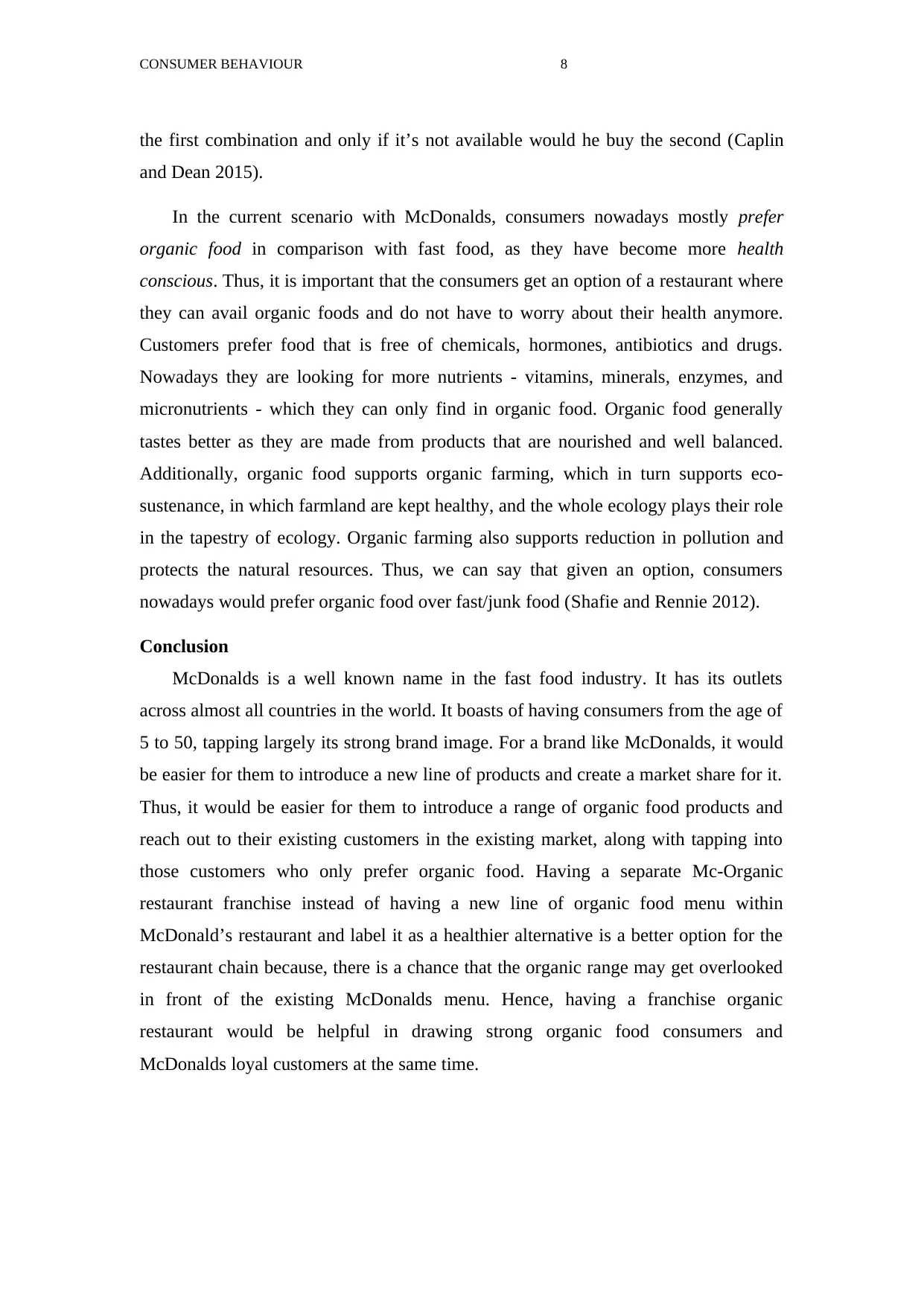
8CONSUMER BEHAVIOUR
the first combination and only if it’s not available would he buy the second (Caplin
and Dean 2015).
In the current scenario with McDonalds, consumers nowadays mostly prefer
organic food in comparison with fast food, as they have become more health
conscious. Thus, it is important that the consumers get an option of a restaurant where
they can avail organic foods and do not have to worry about their health anymore.
Customers prefer food that is free of chemicals, hormones, antibiotics and drugs.
Nowadays they are looking for more nutrients - vitamins, minerals, enzymes, and
micronutrients - which they can only find in organic food. Organic food generally
tastes better as they are made from products that are nourished and well balanced.
Additionally, organic food supports organic farming, which in turn supports eco-
sustenance, in which farmland are kept healthy, and the whole ecology plays their role
in the tapestry of ecology. Organic farming also supports reduction in pollution and
protects the natural resources. Thus, we can say that given an option, consumers
nowadays would prefer organic food over fast/junk food (Shafie and Rennie 2012).
Conclusion
McDonalds is a well known name in the fast food industry. It has its outlets
across almost all countries in the world. It boasts of having consumers from the age of
5 to 50, tapping largely its strong brand image. For a brand like McDonalds, it would
be easier for them to introduce a new line of products and create a market share for it.
Thus, it would be easier for them to introduce a range of organic food products and
reach out to their existing customers in the existing market, along with tapping into
those customers who only prefer organic food. Having a separate Mc-Organic
restaurant franchise instead of having a new line of organic food menu within
McDonald’s restaurant and label it as a healthier alternative is a better option for the
restaurant chain because, there is a chance that the organic range may get overlooked
in front of the existing McDonalds menu. Hence, having a franchise organic
restaurant would be helpful in drawing strong organic food consumers and
McDonalds loyal customers at the same time.
the first combination and only if it’s not available would he buy the second (Caplin
and Dean 2015).
In the current scenario with McDonalds, consumers nowadays mostly prefer
organic food in comparison with fast food, as they have become more health
conscious. Thus, it is important that the consumers get an option of a restaurant where
they can avail organic foods and do not have to worry about their health anymore.
Customers prefer food that is free of chemicals, hormones, antibiotics and drugs.
Nowadays they are looking for more nutrients - vitamins, minerals, enzymes, and
micronutrients - which they can only find in organic food. Organic food generally
tastes better as they are made from products that are nourished and well balanced.
Additionally, organic food supports organic farming, which in turn supports eco-
sustenance, in which farmland are kept healthy, and the whole ecology plays their role
in the tapestry of ecology. Organic farming also supports reduction in pollution and
protects the natural resources. Thus, we can say that given an option, consumers
nowadays would prefer organic food over fast/junk food (Shafie and Rennie 2012).
Conclusion
McDonalds is a well known name in the fast food industry. It has its outlets
across almost all countries in the world. It boasts of having consumers from the age of
5 to 50, tapping largely its strong brand image. For a brand like McDonalds, it would
be easier for them to introduce a new line of products and create a market share for it.
Thus, it would be easier for them to introduce a range of organic food products and
reach out to their existing customers in the existing market, along with tapping into
those customers who only prefer organic food. Having a separate Mc-Organic
restaurant franchise instead of having a new line of organic food menu within
McDonald’s restaurant and label it as a healthier alternative is a better option for the
restaurant chain because, there is a chance that the organic range may get overlooked
in front of the existing McDonalds menu. Hence, having a franchise organic
restaurant would be helpful in drawing strong organic food consumers and
McDonalds loyal customers at the same time.
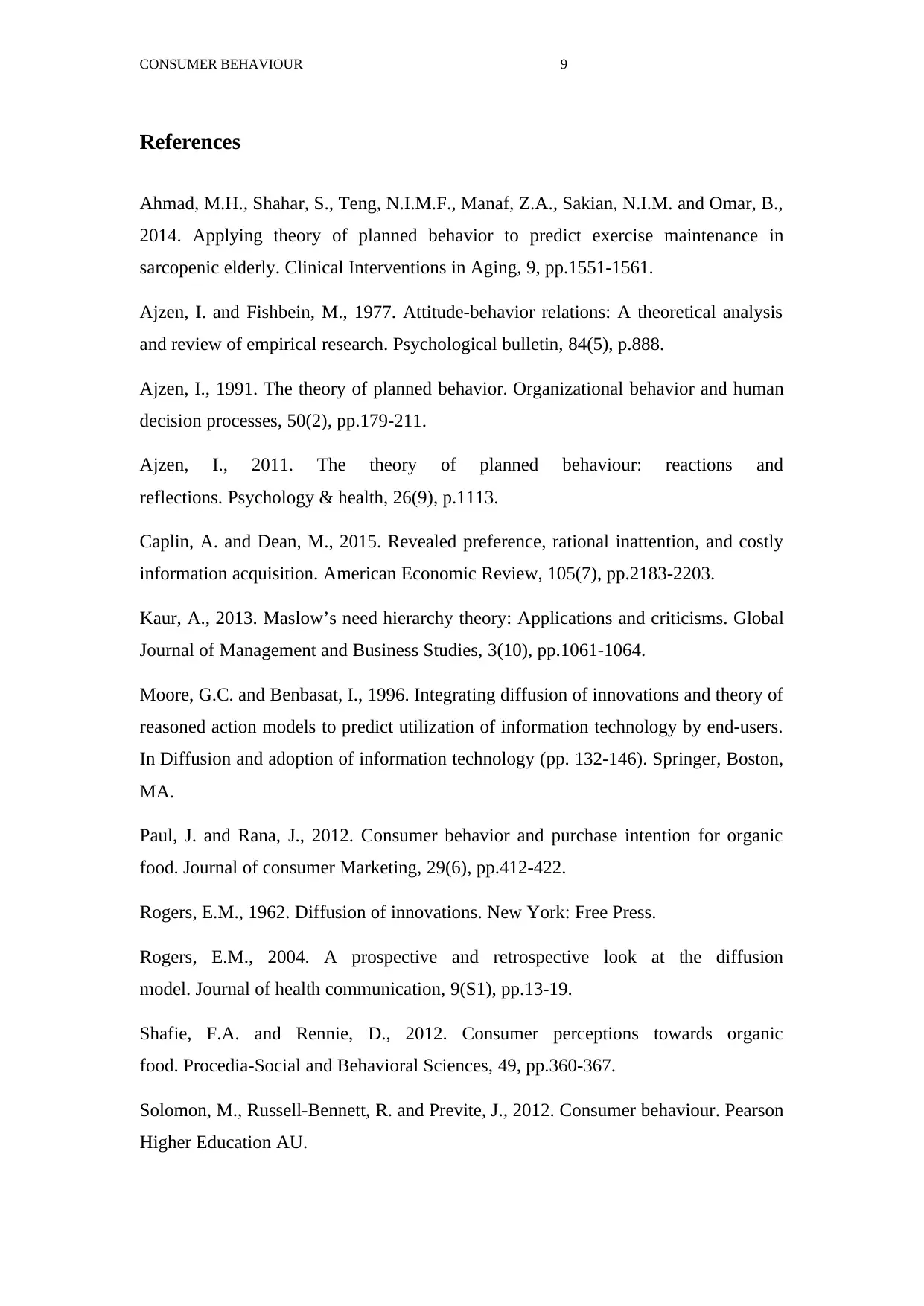
9CONSUMER BEHAVIOUR
References
Ahmad, M.H., Shahar, S., Teng, N.I.M.F., Manaf, Z.A., Sakian, N.I.M. and Omar, B.,
2014. Applying theory of planned behavior to predict exercise maintenance in
sarcopenic elderly. Clinical Interventions in Aging, 9, pp.1551-1561.
Ajzen, I. and Fishbein, M., 1977. Attitude-behavior relations: A theoretical analysis
and review of empirical research. Psychological bulletin, 84(5), p.888.
Ajzen, I., 1991. The theory of planned behavior. Organizational behavior and human
decision processes, 50(2), pp.179-211.
Ajzen, I., 2011. The theory of planned behaviour: reactions and
reflections. Psychology & health, 26(9), p.1113.
Caplin, A. and Dean, M., 2015. Revealed preference, rational inattention, and costly
information acquisition. American Economic Review, 105(7), pp.2183-2203.
Kaur, A., 2013. Maslow’s need hierarchy theory: Applications and criticisms. Global
Journal of Management and Business Studies, 3(10), pp.1061-1064.
Moore, G.C. and Benbasat, I., 1996. Integrating diffusion of innovations and theory of
reasoned action models to predict utilization of information technology by end-users.
In Diffusion and adoption of information technology (pp. 132-146). Springer, Boston,
MA.
Paul, J. and Rana, J., 2012. Consumer behavior and purchase intention for organic
food. Journal of consumer Marketing, 29(6), pp.412-422.
Rogers, E.M., 1962. Diffusion of innovations. New York: Free Press.
Rogers, E.M., 2004. A prospective and retrospective look at the diffusion
model. Journal of health communication, 9(S1), pp.13-19.
Shafie, F.A. and Rennie, D., 2012. Consumer perceptions towards organic
food. Procedia-Social and Behavioral Sciences, 49, pp.360-367.
Solomon, M., Russell-Bennett, R. and Previte, J., 2012. Consumer behaviour. Pearson
Higher Education AU.
References
Ahmad, M.H., Shahar, S., Teng, N.I.M.F., Manaf, Z.A., Sakian, N.I.M. and Omar, B.,
2014. Applying theory of planned behavior to predict exercise maintenance in
sarcopenic elderly. Clinical Interventions in Aging, 9, pp.1551-1561.
Ajzen, I. and Fishbein, M., 1977. Attitude-behavior relations: A theoretical analysis
and review of empirical research. Psychological bulletin, 84(5), p.888.
Ajzen, I., 1991. The theory of planned behavior. Organizational behavior and human
decision processes, 50(2), pp.179-211.
Ajzen, I., 2011. The theory of planned behaviour: reactions and
reflections. Psychology & health, 26(9), p.1113.
Caplin, A. and Dean, M., 2015. Revealed preference, rational inattention, and costly
information acquisition. American Economic Review, 105(7), pp.2183-2203.
Kaur, A., 2013. Maslow’s need hierarchy theory: Applications and criticisms. Global
Journal of Management and Business Studies, 3(10), pp.1061-1064.
Moore, G.C. and Benbasat, I., 1996. Integrating diffusion of innovations and theory of
reasoned action models to predict utilization of information technology by end-users.
In Diffusion and adoption of information technology (pp. 132-146). Springer, Boston,
MA.
Paul, J. and Rana, J., 2012. Consumer behavior and purchase intention for organic
food. Journal of consumer Marketing, 29(6), pp.412-422.
Rogers, E.M., 1962. Diffusion of innovations. New York: Free Press.
Rogers, E.M., 2004. A prospective and retrospective look at the diffusion
model. Journal of health communication, 9(S1), pp.13-19.
Shafie, F.A. and Rennie, D., 2012. Consumer perceptions towards organic
food. Procedia-Social and Behavioral Sciences, 49, pp.360-367.
Solomon, M., Russell-Bennett, R. and Previte, J., 2012. Consumer behaviour. Pearson
Higher Education AU.
⊘ This is a preview!⊘
Do you want full access?
Subscribe today to unlock all pages.

Trusted by 1+ million students worldwide
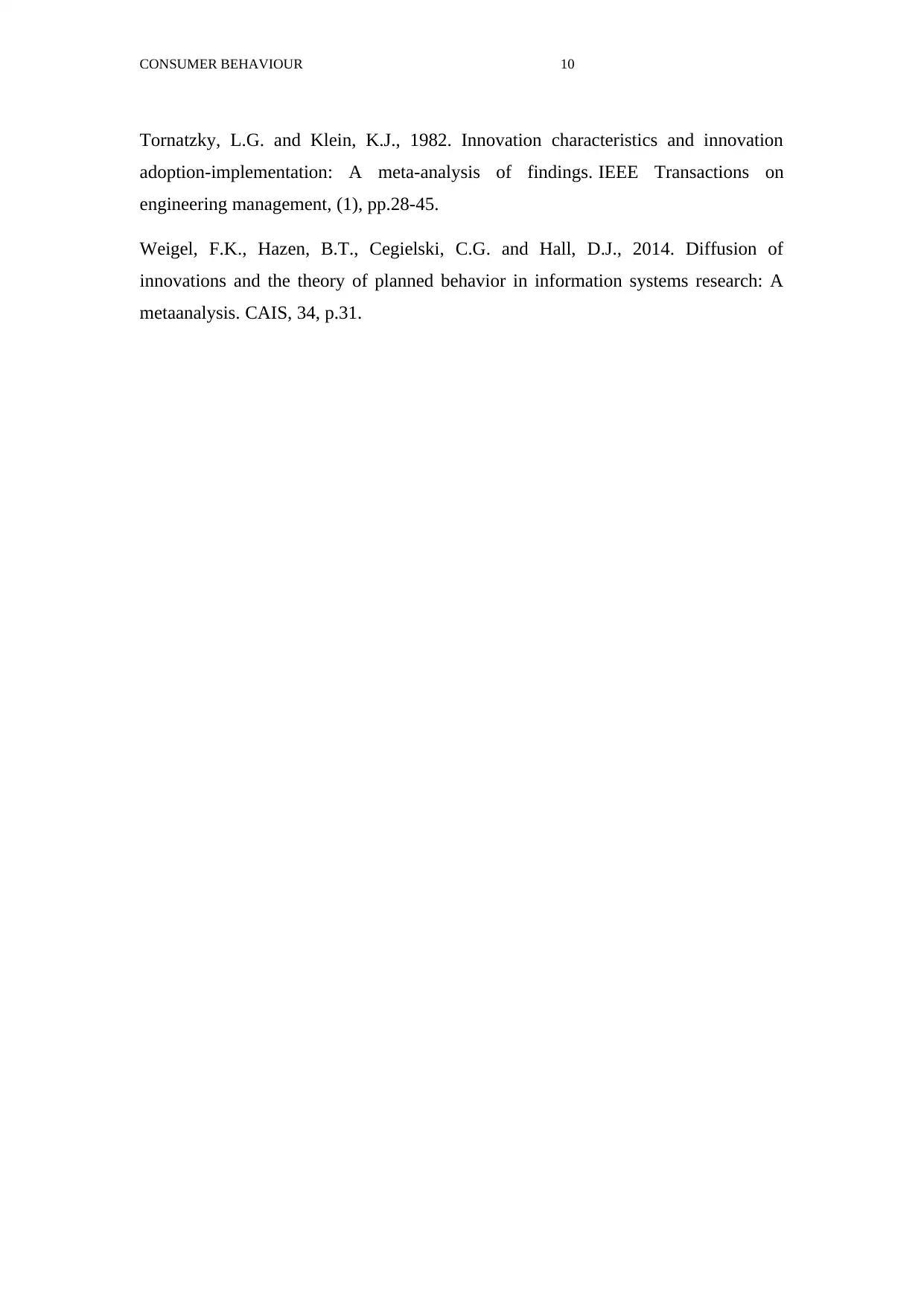
10CONSUMER BEHAVIOUR
Tornatzky, L.G. and Klein, K.J., 1982. Innovation characteristics and innovation
adoption-implementation: A meta-analysis of findings. IEEE Transactions on
engineering management, (1), pp.28-45.
Weigel, F.K., Hazen, B.T., Cegielski, C.G. and Hall, D.J., 2014. Diffusion of
innovations and the theory of planned behavior in information systems research: A
metaanalysis. CAIS, 34, p.31.
Tornatzky, L.G. and Klein, K.J., 1982. Innovation characteristics and innovation
adoption-implementation: A meta-analysis of findings. IEEE Transactions on
engineering management, (1), pp.28-45.
Weigel, F.K., Hazen, B.T., Cegielski, C.G. and Hall, D.J., 2014. Diffusion of
innovations and the theory of planned behavior in information systems research: A
metaanalysis. CAIS, 34, p.31.
1 out of 10
Related Documents
Your All-in-One AI-Powered Toolkit for Academic Success.
+13062052269
info@desklib.com
Available 24*7 on WhatsApp / Email
![[object Object]](/_next/static/media/star-bottom.7253800d.svg)
Unlock your academic potential
Copyright © 2020–2025 A2Z Services. All Rights Reserved. Developed and managed by ZUCOL.




